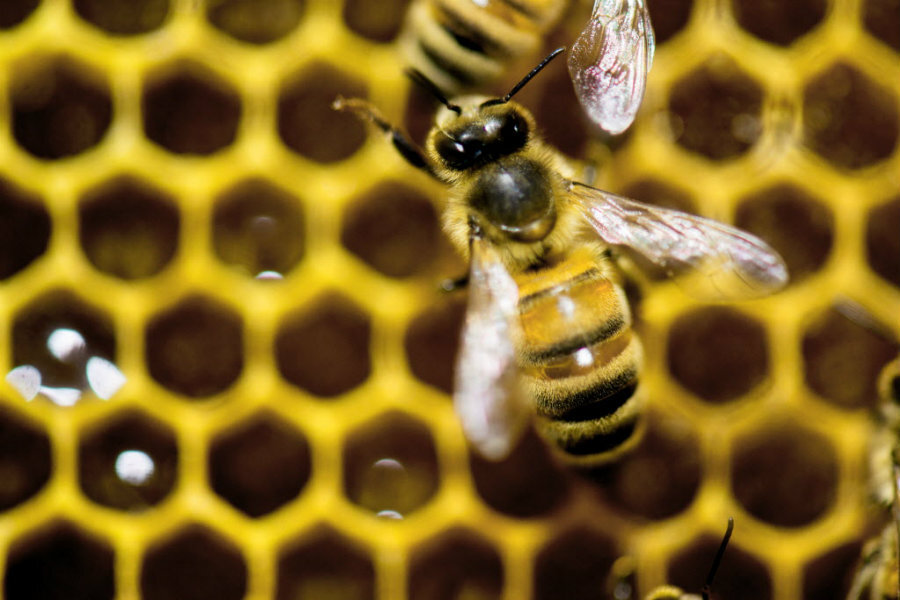Why more research needs to be done to save honey bees
Loading...
The honey bees are disappearing.
In a 12-month period ending in April, populations of managed honey bee colonies in the United States dropped by more than 40 percent — up from about a 35 percent drop the previous year, and the second-highest annual loss recorded to date, according to a US Department of Agriculture (USDA) report released Wednesday.
The findings are consistent with concerns over a decline in bee colonies worldwide, even as researchers, government agencies, and agricultural companies look for ways to reverse the losses.
“Such high colony losses in the summer and year-round remain very troubling,” Jeff Pettis, a senior entomologist at the USDA’s Agricultural Research Service bee research lab in Beltsville, Ma., said in a statement. This is despite fewer signs in the last few years of colony collapse disorder (CCD), a syndrome in which workers in a honey bee colony disappear, he said.
“If beekeepers are going to meet the growing demand for pollination services, researchers need to find better answers to the host of stresses that lead to both winter and summer colony losses,” he added.
Honey bees are vital to both local ecosystems and the economy. Bee pollination accounts for more than $15 billion in increased crop value every year, according to the USDA, and is a crucial to growing plants that produce a quarter of the food consumed by Americans, Reuters reported.
If losses continue at the current rate — or worse, continue to rise — “it could threaten the economic viability of the bee pollination industry,” the USDA warned. “[T]he cost of honey bee pollination services would rise, and those increased costs would ultimately be passed on to consumers through higher food costs.”
Scientists have identified multiple causes for the declining bee population, including mite infestations and poor diets due to climate change, drought, and urban development.
The main debate, however, is centered on neonicotinoids, a type of pesticide chemically similar to nicotine and often applied to seeds. Three — clothianidin, imidacloprid and thiamethoxam — have been banned in the European Union because of concerns about the chemicals’ harmful effect on honey bees. In April, the US Environmental Protection Agency announced that it would not approve most applications for new uses of neonicotinoids pending results from pollinator risk studies.
As it stands, the data around neonicotinoids are mixed.
“Many studies that link the poor health of bee colonies to the pesticides have been criticized, for example for not using realistic doses,” science journal Nature reported. “Some defenders of the chemicals have argued that if neonicotinoids are harmful, bees will learn to avoid treated plants.”
In April, two teams published separate reports that sought to fill the gaps that critics have identified in previous research. “Taken together, the two studies point to a compound that, with repeated exposure, can be detrimental to bees who can't stop themselves from going back for more,” The Christian Science Monitor’s Pete Spotts wrote.
As the debate continues, efforts are underway to better understand and protect bees and safeguard the country’s agricultural industry. Last year, in the face of criticism from farm organizations and pesticide companies, the White House created a task force to develop a health strategy around bees and other pollinators.
Some initiatives have focused on alternatives to honey bees for pollination, in particular looking at the potential of other bee species.
Still others are turning to genetic modification for the answer. Using genetic technologies to actually manipulate the bee genome could lead to deeper insights into how bees fight infections or parasites like Varroa mites, as well as the genetic basis for bee behavior, wrote David O’Brochta, a professor in the University of Maryland, College Park's Institute for Bioscience and Biotechnology Research and the Department of Entomology, wrote for Entomology Today.
“Just as the human genome enables human biology to be understood for the purposes of developing therapeutics and solutions to unwanted conditions,” he added, “these results represent the beginning of a similar phase of bee research.”








